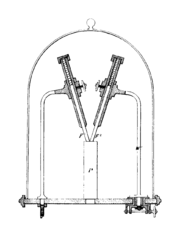William Edwards Staite
William Edwards Staite (born April 19, 1809 in Bristol , † September 26, 1854 in Caen ) was an English inventor. He developed and patented a number of improved arc lamps , partly together with William Petrie . Because of his early death and the reliance of his lamps on batteries as the only available energy source, he did not achieve commercial success.
Life
Staite worked for the iron merchant John Webb and Company for a while. In 1841, together with the London engineer Kennard, he developed a rotary steam engine with a turbine and improved steam openings. However, the performance of this machine turned out to be less than that of the conventional piston steam engine; a similar working system was not introduced by others until more than 50 years later. In 1844, Staite patented a method for obtaining extracts and concentrates, which was used successfully many times. In his spare time, Staite worked as an author and published several works.
According to its own statements, Staite tried to create permanent electrical light as early as 1834. He succeeded in doing this twelve years later with either rotating or fixed carbon or platinum electrodes sharpened at several points in an airtight, transparent vessel. The light was produced partly by the arc and partly by the glowing electrode ends. For this system he was granted a patent on February 7, 1846 together with the arms manufacturer William Greener.
At the end of 1846, Staite introduced an improved lamp in which a clockwork or spring system provided fresh coal for the electrodes. He patented this invention on November 12th and demonstrated it several times in public. Joseph Wilson Swan reported that at one of Staite's lectures he made the decision to experiment with incandescent lamps himself.
Four other improved arc lamps were patented under Staite's name. The first three were based on designs by William Petrie , but Petrie's name was only mentioned in one case. Perhaps Staite refused to give Petries a financial share in the inventions.
During a long stay in Manchester in 1850 and 1851, Staite publicly demonstrated his arc lamp and received considerable coverage in the regional press. A committee was formed to decide on the general use of Staite's lamps. It decided against it because the high consumption of metal plates and acids would have meant high costs for the battery and the lamps were perceived as flickering.
After another demonstration at Worsley Hall, attended by high-ranking guests like Queen Victoria , railroad companies showed serious interest in the lamps. In the following years Staite installed his lamps on a trial basis in the train station and at the port of Liverpool. The attempts were successful, but Staite ran into financial difficulties and could not advertise his inventions sufficiently. His health deteriorated noticeably. Staite died during a recreational stay in Normandy. His grave is in Wallasey , Cheshire.
literature
- G. Woodward: Staite and Petrie: pioneers of electric lighting. IEEE Proceedings of Science, Measurement and Technology 136, 6 (Nov. 1989): 290-296, ISSN 0960-7641
| personal data | |
|---|---|
| SURNAME | Staite, William Edwards |
| BRIEF DESCRIPTION | English inventor |
| DATE OF BIRTH | April 19, 1809 |
| PLACE OF BIRTH | Bristol , England |
| DATE OF DEATH | September 26, 1854 |
| Place of death | Caen , France |

